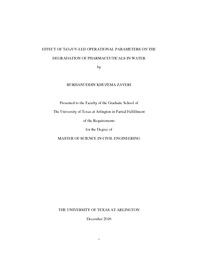
ATTENTION: The works hosted here are being migrated to a new repository that will consolidate resources, improve discoverability, and better show UTA's research impact on the global community. We will update authors as the migration progresses. Please see MavMatrix for more information.
Show simple item record
| dc.contributor.advisor | Choi, Hyeok | |
| dc.creator | Khuzema Zaveri, Burhanuddin | |
| dc.date.accessioned | 2017-02-14T15:57:39Z | |
| dc.date.available | 2017-02-14T15:57:39Z | |
| dc.date.created | 2016-12 | |
| dc.date.issued | 2016-12-19 | |
| dc.date.submitted | December 2016 | |
| dc.identifier.uri | http://hdl.handle.net/10106/26390 | |
| dc.description.abstract | The presence of pharmaceutical residues in water resources has alarmed water and health authorities. Among many treatment technologies for pharmaceuticals, ultraviolet (UV)-based oxidation has gained significant attention because it is capable of decomposing a variety of recalcitrant and toxic chemicals. As an alternative UV source to problematic conventional mercury lamps, light-emitting diode (LED) has shown many advantages for water treatment applications, so-called UV-LED. The overall goal of this study is to evaluate the high potential of the UV-LED technology to treat water contaminated with pharmaceuticals including sulfamethoxazole, ibuprofen, and triclosan. In particular, important operational parameters were investigated, including UV wavelength, irradiation intensity, reaction pH, and TiO2 loading. The effect of the operational parameters on the decomposition of the pharmaceuticals was discussed, and optimized operation conditions were proposed. Photolytic decomposition of the pharmaceuticals was also compared with their photocatalytic decomposition. Photolytic decomposition of the pharmaceuticals was solely determined by relation between their UV absorption characteristics and the UV emission spectra of LEDs. Both photolytic decomposition and photocatalytic decomposition were greatly affected by reaction pH. The presence of TiO2 in cases that significant photolysis was present, rather inhibited the overall decomposition process. However, in all cases, photocatalysis showed better mineralization than photolysis. | |
| dc.format.mimetype | application/pdf | |
| dc.language.iso | en_US | |
| dc.subject | Advanced oxidation processes | |
| dc.subject | Pharmaceuticals | |
| dc.subject | Photolysis | |
| dc.subject | TiO2 photocatalysis | |
| dc.subject | UV light-emitting diode | |
| dc.title | EFFECT OF TiO2/UV-LED OPERATIONAL PARAMETERS ON THE DEGRADATION OF PHARMACEUTICALS IN WATER | |
| dc.type | Thesis | |
| dc.degree.department | Civil Engineering | |
| dc.degree.name | Master of Science in Civil Engineering | |
| dc.date.updated | 2017-02-14T15:57:39Z | |
| thesis.degree.department | Civil Engineering | |
| thesis.degree.grantor | The University of Texas at Arlington | |
| thesis.degree.level | Masters | |
| thesis.degree.name | Master of Science in Civil Engineering | |
| dc.type.material | text | |
Files in this item
- Name:
- KHUZEMAZAVERI-THESIS-2016.pdf
- Size:
- 846.9Kb
- Format:
- PDF
This item appears in the following Collection(s)
Show simple item record


